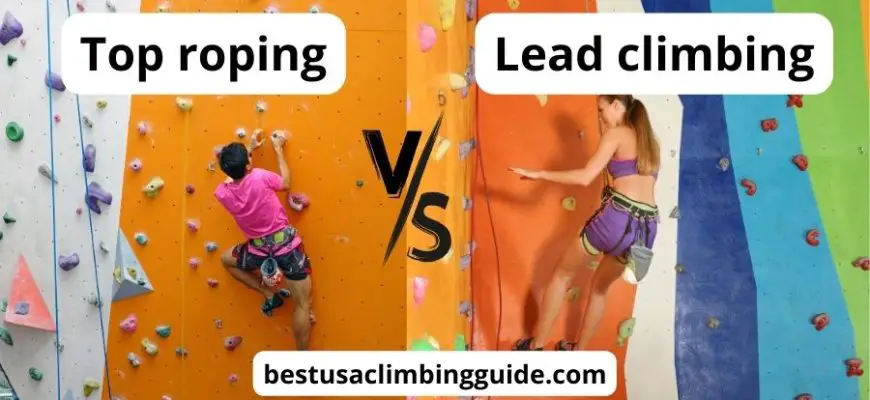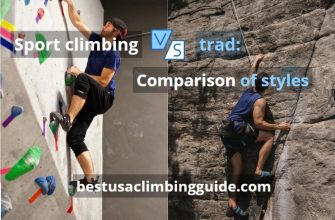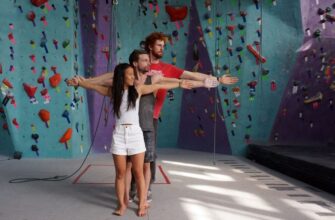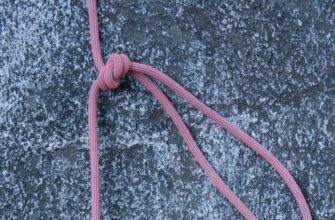Top roping vs lead climbing? Rock climbing is a very fast-growing and interesting sport that is becoming more popular by the day. At the heart of the rock climbing world lies two popular and primary techniques: top roping and lead climbing, these two techniques provide climbers with different experiences, different challenges, and growth opportunities.
In this article we will carefully examine the features and distinctions between the two techniques, providing you with everything you need to know to make the right choice when climbing as we explore “Lead climbing vs Top roping”.
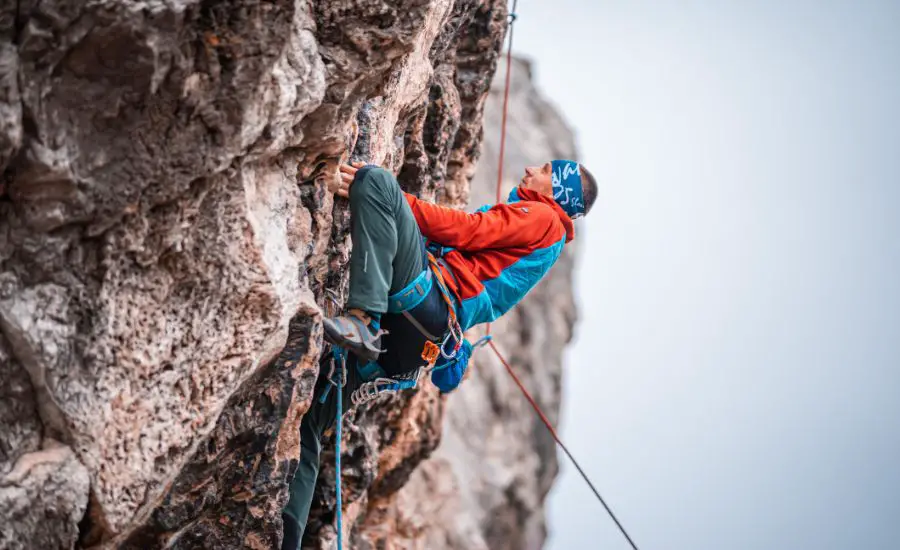
- Top roping: overview
- Lead climbing: overview
- Similarities
- Top roping vs lead climbing: risk level
- Difficulty and experience
- Belay technique
- Application
- FAQ
- What’s the difference between lead and top rope?
- Is lead harder than top rope?
- What is top roping and lead climbing?
- Is top roping harder than bouldering?
- Conclusion
Top roping: overview
The top-roping technique involves a climber ascending a route like outdoor crags while being supported from the top by a partner or belay device that is anchored above.
Top-roping is the best way for new climbers to get started, it offers a secure and regulated environment where basic abilities like footwork, handholds, and balance, can be developed while reducing the risks frequently connected to lead climbing.
When climbing ropes climbers can concentrate on their moves with the security of a belayer above them rather than having to worry about controlling potential falls or setting protection when they top rope.
One of the primary advantages of top-rope climbing is the enhanced safety it offers, in top-rope belaying, the climber is secured by a rope that runs from their harness, up to an anchor at the top of the climbing route, and then down to their belayer.
The top rope setup significantly reduces the fall distance of the climber, this minimizes the chances for injury in top rope belaying.
Due to its easy learning curve, top-rope climbing is frequently used for climbing gyms and instructional programs, beginners will build confidence as they gradually advance to more challenging routes like outdoor crags.
Climbers learn to read routes, plan movements, and use grips effectively as they develop their abilities. These are all transferrable skills to other sport climbing or rock climbing categories like lead climbing, mixed climbing, and ice climbing.
Climbers need to ensure certain equipment is available before they start climbing, this equipment includes a climbing harness, a helmet for protection, climbing shoes for improved grip, and a belay device for the partner controlling the rope to ensure the rope catches you when necessary.
Although top-rope climbing is excellent for starters, experts too may use it, climbers with experience can use top-roping to better their skills, perfect their motions, and build endurance without dealing with the additional difficulty of having to lead climb.
Lead climbing: overview
Lead climbing involves climbing the route while attaching the rope to the protection points placed along the route, when you lead climb, the climber takes the rope with them while ascending, clipping it into the protection spots.
This approach is more complex because climbers must plan their movements, clip the rope effectively, and prevent falls when they lead climb.
A climber’s technique, mental focus, and problem-solving skills are put to the test in lead climbing, a lead climber must carefully choose their resting spots, plan their movements, and read the route, when you lead climb, the rope must be fastened to protection points using efficient clipping methods to prevent lead falls and decrease rope drag in case the climber falls.
Lead climbing places a larger priority on safety precautions because of the increased risk of falls, helmets are worn by when you lead climb to protect you from falling stuff, and partners must manage the rope carefully to prevent pendulum swings or a situation where the climber falls.
To ensure a secure climbing experience, proper clipping techniques and excellent communication between the climber and the belayer are essential.
A lead climber relies on a wide range of tools including helmets, climbing harnesses, climbing shoes, and paired carabiners.
Belay devices are specialized equipment that aids with managing the rope, and a dynamic climbing rope is essential for preventing lead climbers from possible falls.
Beginners can start with easier routes to learn the basics of lead climbing, gradually building their confidence and skill set, more experienced climbers can push their limits by tackling harder, more interesting sport climbing sports like trad climbing.
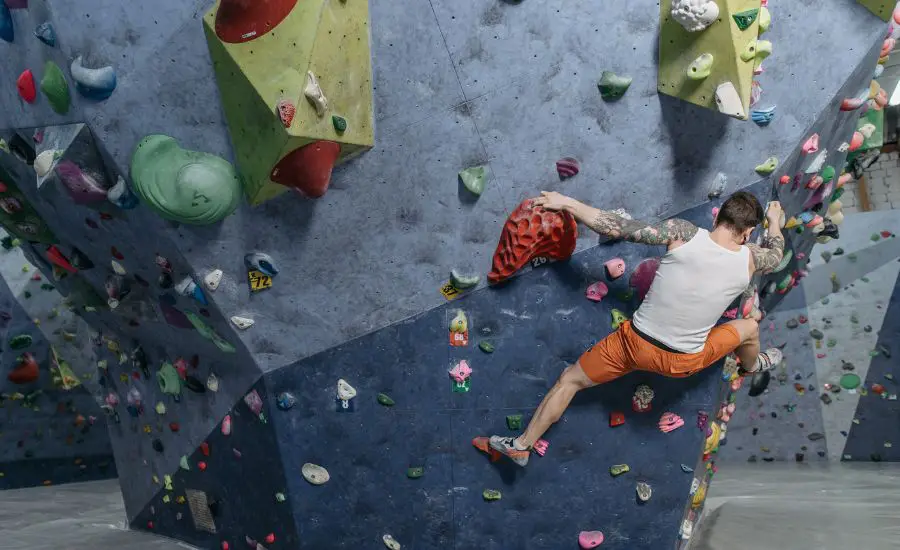
Similarities
A strong foundation in climbing methods is necessary for both lead and top-rope climbing, regardless of the climbing method, fundamental abilities including appropriate footwork, handholds, balance, and body placement are a need.
Perfecting these fundamentals is essential for effective and secure advancement whether you’re leading a climb outdoors or climbing a top-rope route in a climbing gym, having the ability to overcome obstacles on the wall is essential for both top-rope and lead climbs.
Both techniques can be practiced on the same route, both methods also offer climbers the opportunity to select routes that match their skill level, providing a perfect environment for climbers of different abilities to challenge themselves and improve their techniques.
While the mechanics of rope management differ between the two methods, the concept remains the same, in top-roping, the rope is anchored at the top, and in lead climbing, it is carried by the climber and clipped to protection points.
Both scenarios can be carried out on the same route and they both require an understanding of rope handling, avoiding tangles, and ensuring the rope doesn’t hinder movement.
Whether at indoor climbing gyms or public crags, top-rope, and lead climbing are common in social settings, regardless of the climbing technique they use, climbers develop a sense of friendship and unity via their shared experiences of completing routes and celebrating successes, and encouraging one another.
Top roping vs lead climbing: risk level
When comparing lead climbing vs top roping, risk is an important factor usually considered, risk is an important part of climbing, regardless of the technique used, it depends on several factors, including the climber’s ability level, the terrain’s characteristics, the equipment utilized, and the height of the climb.
Although there is some risk involved in both top-roping and lead climbing, it is important to understand each technique’s special characteristics to make the best choices when climbing.
For beginners top-rope climbing is often considered as the safest alternative, as the climber ascends he is held in place by a rope that extends from their harness down to a belayer, passing through an anchor at the top of the route.
The belayer’s job is to control slack, prevent falls, and ensure that the climber is caught immediately if he falls mistakenly.
Top-rope routes are chosen with safety in mind, the routes are predetermined, and protection points are established at the top of the climb, as a result, the climber is less exposed to the risk of making incorrect protection decisions or falling from heights that could lead to fatal injuries.
Proper use of safety equipment, such as helmets, harnesses, and climbing shoes, is essential in minimizing risk, climbers should assess the difficulty of routes, their abilities, and the nature of the protection points before attempting a climb.
The responsibility of ensuring a safe fall rests on both the climber and the belayer, the climber must select appropriate protection placements, manage rope drag, and avoid dangerous falls.
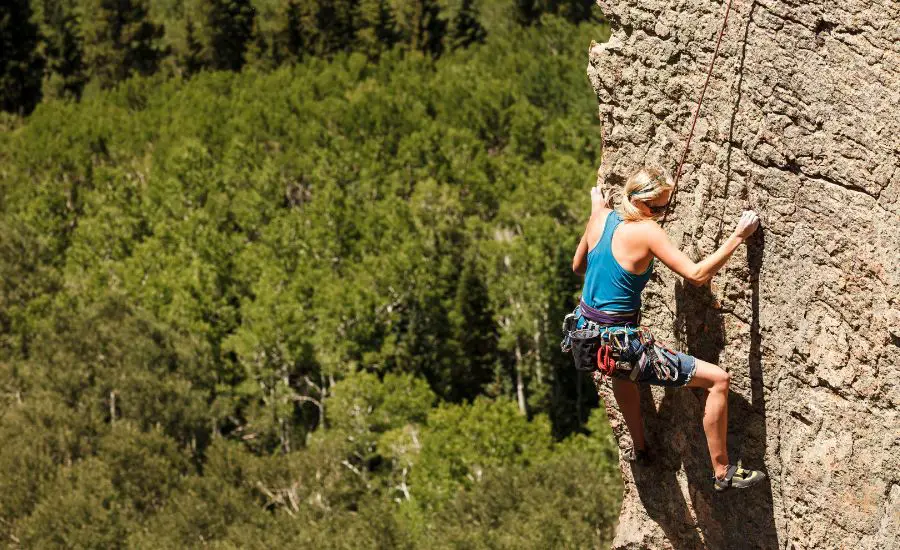
Difficulty and experience
Top-roping routes are frequently chosen for their beginner-friendly qualities since they offer more noticeable and accessible grips, and are generally less difficult.
With this technique, beginners can learn crucial climbing techniques like balance, footwork, and handholds in a controlled setting without having to worry about managing rope clipping and protection placements.
Lead climbing adds a new level of complexity and difficulty, as they move up the course, climbers carry the rope with them and clip it into various secure points.
Before you start lead climbing perfecting strategic thinking and effective rope management is essential, the ability to quickly evaluate where to place the rope is equally important, lead climbing routes are more difficult generally because they frequently have smaller grips and steeper angles.
The journey of transitioning from top rope to lead climbing is a natural progression that challenges climbers to better their skills, conquer fears, and embrace the thrill of more complex and demanding routes.
Less expertise is required for top-rope climbing than for lead climbing, but new climbers still need to understand the essential methods and safety precautions.
Essential qualifications include learning how to use climbing equipment safely and how to effectively communicate with a belayer. Climbers can gradually take on more difficult top-rope routes as they advance to improve their skills and boost their confidence.
Belay technique
Belaying is the process of controlling the climbing rope to protect the climber from falling, a belay mechanism is used to shut off the rope so that the belayer may manage the rope’s tension if required to stop the climber from falling.
Although the fundamental ideas are the same, top-roping and lead climbing use these approaches differently.
Top-rope belaying is often considered the easier of the two techniques, making it an excellent start for individuals who are new to belaying, setting up entails placing the lead belay at the base of the climb and anchoring the rope at the top of the route.
The lead belay controls the tension of the rope as the climber ascends, taking in slack to keep the climber from falling, proper communication prevents misunderstandings and contributes to a seamless climbing experience.
The belay technique for lead climbing is more complicated due to the method’s heightened dynamics. Lead climbing involves carrying the rope and climbing while clipping it into protection points, following the climber’s progression, the belayer tightens the rope to prevent falls by taking in slack as they advance.
Application
Effective rope management is required for lead climbing and roped climbing applications in general, rope drag must be minimized while climbers effortlessly clip the rope into safety points. A smooth climb is ensured by effective clipping, which also lowers the risk of falls brought on by high rope tension.
Top-rope routes are graded with varying degrees of difficulty, offering climbers a progressive path to develop their skills. As climbers become more comfortable and proficient, they can gradually tackle routes of increasing complexity, refining their technique and preparing for more advanced climbing methods.
To reduce the risk of long falls, climbers must evaluate the route for accurate protection points and make sure they are spaced appropriately. Strategic placement also involves considering the terrain’s difficulty and the climber’s stamina to ensure safe and sustainable progress.
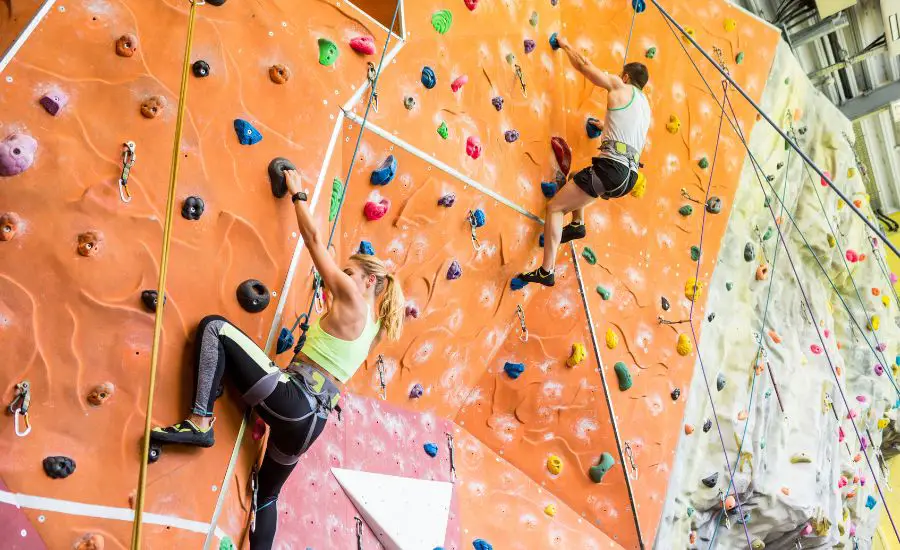
FAQ
What’s the difference between lead and top rope?
In lead climbing, the climber carries the rope with them as they ascend while in top roping, the rope is anchored at the top of the route.
Is lead harder than top rope?
Lead climbing is considered more challenging than top rope because it involves carrying the rope with you as you climb.
What is top roping and lead climbing?
Top roping is a climbing technique that involves a rope anchored to the top of the route and lead climbing is a technique that involves the climber carrying the rope with them.
Is top roping harder than bouldering?
Bouldering is considered harder than top roping because it demands higher levels of strength and intense movements.
Conclusion
Ultimately the decision between these methods depends on one’s goals and desire for development, top roping offers a solid foundation for individuals seeking an enjoyable beginning to climbing while lead climbing is an amazing option for individuals ready to tackle complex landscapes.
Using this article as a guide you can comfortably choose the best technique for you and secure a worthy and unforgettable climbing experience.

